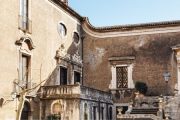After leaving Santa Cruz del Norte we headed back onto the highway and a few minutes later were deposited at a lonely railway station to await our guide. The station house, badly in need of a paint job, sat almost deserted, except for a gaunt old man in ragged clothes on a bench, who clutched a large plastic container full of over-ripe tomatoes. A large, lop-sided sign, dangling from two rusty chains proclaimed the name of the town. We were very surprised to read the name, “Hershey”. We soon learned that we were on the edge of a former model town and sugar refinery built by the American chocolate tycoon, Milton S. Hershey, in 1916 to supply sugar for his chocolate empire back in the United States.
We were standing at the terminus of an electric railway that Hershey built to connect the town to Havana and Matanzas in order to transport workers, sugar cane, and the refined product. Although the station house sign survives, the town was renamed after the revolutionary hero, Camilo Cienfuegos, mentioned earlier. The locals have never become accustomed to using this name as they have always called the town AIR-shee.
When completed, Hershey’s model town was the envy of all Cubans. He certainly was a benevolent employer who treated his workers very well. The town contained 160 neat wooden houses with front porches and yards anchored along a grid system of streets, American-style. An elegant stone hotel and a few large houses were built for the American supervisors. He built a public school, medical clinic, shops, movie theatre, golf course, social clubs, and baseball stadium as well as the huge sugar refinery which proved to be one of the most productive in all of Cuba.

Sadly, except for the modest houses, still occupied, but in dire need of repairs, most of the town’s amenities that Hershey built have long disappeared or have fallen into ruins. The heart of the town is now a ragged, deteriorating shambles. Weeds grow through the cement sidewalks, skeletal remains of once attractive stone buildings are partially hidden by overgrown grasses and shrubs. Trash litters the roadsides. The town’s centre is a hollowed out string of unpainted, dilapidated shops with practically nothing to sell. The huge refinery with its three enormous smoke stacks poking up into the sky, lies empty, crumbling, and abandoned, except for one small section that now produces ceramic tiles.
Hershey died in 1945 and since he had no heirs the whole enterprise was sold to a very wealthy Cuban in 1948. He owned it until it was nationalized in 1959. Although the town rapidly deteriorated after the revolution, the refinery was kept in production until in 2003. The plant became no longer viable when Cuba lost its major sugar market after the collapse of the Soviet Union, its major customer.
When the Soviet Union collapsed, all the countries under its control, ironically including Russia itself, the state that enslaved them all, cast aside the stultifying life of communism after 70 years of brutal dictatorship. The “classless” society that nationalized everything and squashed all individual initiative had proven to be an unworkable and badly flawed form of government that tightly controlled its people making them prisoners in their own land. Cuba, an accidental dictatorship, was now without the protection of the once-powerful Soviets. It had long since severed ties with its close neighbour, the USA. The Americans, starting with President Eisenhower in 1959, would not accept the loss of billions of dollars of American property, businesses, and investment, and aggressively, but unsuccessfully, plotted the government’s overthrow. Although Cuba now found itself alone in the world, it still defiantly thumbed its nose at the USA and adhered to its communist style of government.





Peter Scotchmer4 years ago
An outstandingly accurate portrait of a land where time has stood still due to the great evil of the obsolescent and brutal Stalinist ideology that brought its overseers to power in 1959. I vividly recall, at the age of nine, the swaggering fidelista soldiers, with their rifles and beards, surveying Caracas, the capital of Venezuela, from the balcony of a luxury resort hotel that would, they thought, be next in line to fall to Communist tyranny. It took them longer than they had expected, but Venezuela became the next Cuba. As Dr. McDonald has vividly and sympathetically described Cuba in this article, it is a paradise for the tourist, but a grim fortress for its native population.